Libya Landmarks and Monuments
(Libya, LY, North Africa)
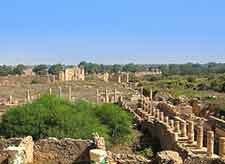
Libya's fascinating landscape includes some very famous natural landmarks, such as both the vast Sahara Desert and the Green Mountains, as well as several beautiful beaches. On top of all this, Libya can boast many beautifully preserved archaeological monuments.
All in all, there are five UNESCO World Heritage Sites in Libya, including the spectacular Leptis Magna Historic Site, ancient Cyrene, the Jebel Acacus Mountains and the old town of
Ghadames. Sabratha is yet another of the country's remarkable UNESCO archaeological sites dating back to Roman times, and if it wasn't for the existence of Leptis Magna, this really would be the jewel in Libya's Roman crown.
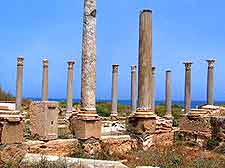
Leptis Magna Historic Site
Address: Leptis Magna, Libya, LY, Africa
Situated to the east of Tripoli and coming with views of the Mediterranean Sea, Leptis Magna is one of Libya's UNESCO World Heritage Sites and really is a must-see. This historic site was once Africa's principal Roman City and is today well preserved, featuring ancient limestone temples, as well as a theatre, marketplaces, Hadrianic bathhouses, a 'natatio' (swimming pool), a hillside amphitheatre and a basilica, all dating from the time of the Roman Empire in the 2nd century AD.
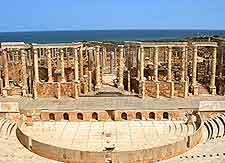
Attractions also include the Nymphaeum (Temple of Nymphs), the Severan Forum, the Great Colonnaded Street, the Temple of Jupiter Dolichenus and the Triumphal Severan Arch, built to commemorate the Roman emperor Septimus Severus, who was born here in 193 AD. Close to the amphitheatre, the Circus (Hippodrome) was once filled with some 25,000 cheering spectators, watching chariot racing and other traditional Roman entertainment.
Open hours: daily
Admission: free
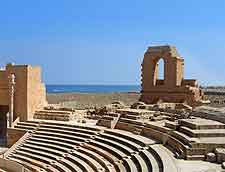
Sabratha
Address: Sabratha, Libya, LY, Africa
Overlooking the Mediterranean at Sabratha are a number of ancient buildings, including the Antonine Temple, the Capitoleum, the Temple of Serapis, the Basilica of Justinian and a Roman theatre. The
Sabratha Roman Museum is best visited towards the end of your time here, so that you will understand what is on display all the better. From the museum, the pathway leading towards the seafront is actually the old Roman thoroughfare known as the Cardo. Nearby is the Mausoleum of Bes, the Byzantine Gate and the Southern Forum Temple, honouring an unknown deity.
Open hours: daily
Admission: free
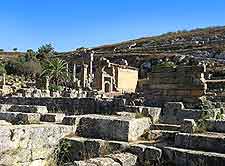
Cyrene
Address: Cyrene, Libya, LY, Africa
This ancient Greek city dates back to the 7th century BC. Founded by Greeks newly arrived from what is now the holiday island of
Santorini, the city was particularly renowned for its cultivation of science and philosophy. Following the Roman invasion, Cyrene was left in ruins. Remains of Greek temples, the Agoro (home of the Capitoleum, the Naval Monument and the Temple of the Octagonal Bases) and the Sanctuary of Apollo can still be seen today, largely untouched since their demise. Also worth looking out for in Cyrene are the mosaics at the House of Hesychius, the Temple of Artemis and the Temple of Zeus. Many people coming to Cyrene as part of an official tour group choose to stay overnight at nearby Al-Bayda, at the Cyrene resort, or alternatively, at the Buyut ash-Shabaab hostel.
Open hours: daily
Admission: free
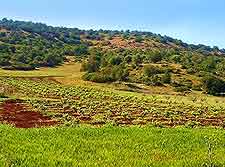
Green Mountains
Address: Green Mountains, Libya, LY, Africa
Known in Arabic as the Akhdar Mountains, this area is renowned for its beautiful scenery, which includes rolling hills, rocky outcrops, waterfalls and gorges. In the past, the mountains have been home to Greek and Italian farmers, with evidence of such occupation often clearly visible in the local architecture. More recently, the Green Mountains have been declared a sustainable development zone that plans to cater for tourists in a more environmentally friendly way.
Open hours: daily
Admission: free
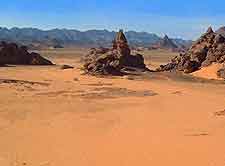
Jebel Acacus Mountains / Tadrart Acacus
Address: Jebel Acacus Mountains, Libya, LY, Africa
Home to the native Tuareg people, this remote desert region can be accessed via the oasis settlement of Ghat. Of particular interest is the prehistoric rock art that can be found in the Wadi Tashwinet area of the mountains. These paintings and carvings first came to light during the mid-19th century. However, it wasn't until the mid-1950s that more detailed studies were carried out. After admiring the ancient art work, outdoor enthusiasts can trek in the various 'wadis' (dry channels) that wind their way through the rocky landscape.
Open hours: daily
Admission: free
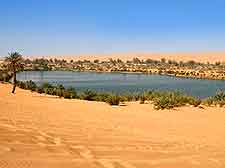
Ubari Lakes
Address: Ubari Lakes, Libya, LY, Africa
Some 11 lakes can be found amidst the sandy 'sea' around Ubari. High salt levels make the Ubari Lakes esecially appealing to swimmers, although in recent years the lowering of the water table has made some of the lakes noticeably shallower. The most popular are the lakes at Mavo and Gebraoun, which can be accessed via four-wheel drive tours.
Open hours: daily
Admission: free
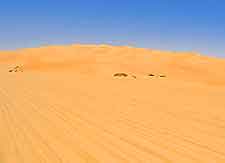
Zallaf Sand Dunes
Address: Zallaf Sand Dunes, Libya, LY, Africa
The Zallaf Sand Dunes offer an opportunity for visitors to relax. These attractive dunes surround beautiful saline mineral lakes that are perfect for bathing. In total there are more than 20 individual lakes, often being close to mature palm trees, providing a tropical flavour. The dunes are the home of the indigenous Tuareg people.
Open hours: daily
Admission: free
 Libya's fascinating landscape includes some very famous natural landmarks, such as both the vast Sahara Desert and the Green Mountains, as well as several beautiful beaches. On top of all this, Libya can boast many beautifully preserved archaeological monuments.
Libya's fascinating landscape includes some very famous natural landmarks, such as both the vast Sahara Desert and the Green Mountains, as well as several beautiful beaches. On top of all this, Libya can boast many beautifully preserved archaeological monuments.
 Attractions also include the Nymphaeum (Temple of Nymphs), the Severan Forum, the Great Colonnaded Street, the Temple of Jupiter Dolichenus and the Triumphal Severan Arch, built to commemorate the Roman emperor Septimus Severus, who was born here in 193 AD. Close to the amphitheatre, the Circus (Hippodrome) was once filled with some 25,000 cheering spectators, watching chariot racing and other traditional Roman entertainment.
Attractions also include the Nymphaeum (Temple of Nymphs), the Severan Forum, the Great Colonnaded Street, the Temple of Jupiter Dolichenus and the Triumphal Severan Arch, built to commemorate the Roman emperor Septimus Severus, who was born here in 193 AD. Close to the amphitheatre, the Circus (Hippodrome) was once filled with some 25,000 cheering spectators, watching chariot racing and other traditional Roman entertainment.




